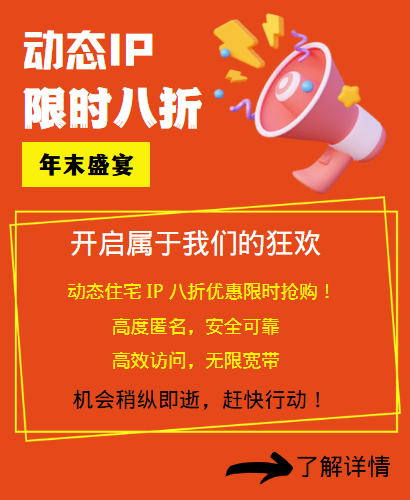In the SEO (search engine optimization) industry, the choice of proxy IP is crucial for the smooth progress of tasks such as data crawling, competitor analysis, and website monitoring. A high-quality proxy IP can not only improve the efficiency and accuracy of tasks, but also effectively protect your business from network risks. This article will explore in depth how to choose the most suitable proxy IP for SEO business, including the types of proxy IPs, key factors, practical considerations, and recommended strategies.

1. Types of proxy IPs and their application scenarios
1.1 HTTP/HTTPS proxy
HTTP and HTTPS proxies are the most commonly used proxy types and are suitable for most web browsing and data crawling tasks. HTTP proxies can forward HTTP requests, while HTTPS proxies support encrypted HTTPS communications.
- Application scenarios: web crawling, data acquisition for SEO tools (such as Ahrefs, SEMrush, etc.), website monitoring, etc.
1.2 SOCKS Proxy
SOCKS proxy is a more general proxy protocol that can forward any type of network traffic, including TCP and UDP protocols. SOCKS proxy is often used in scenarios where multiple protocols and applications need to be processed.
- Application scenarios: social media management, online games, data synchronization, etc.
2. Key factors for selecting proxy IP
2.1 Anonymity
- High anonymity: Choosing a proxy IP with high anonymity can ensure that your real identity and location will not be detected by the target website or server. This is essential to avoid triggering anti-crawler mechanisms and protecting privacy.
2.2 Geographic location
- Choose a geographic location close to the target website: According to your business needs, choosing a proxy IP that is geographically close to the target website or server can reduce latency and increase access speed. This is very important for improving data crawling efficiency and accuracy.
2.3 Stability and Speed
- Stability: Stable proxy IP can reduce the risk of connection failure and data loss, ensuring the smooth progress of the task.
- Speed: Choosing a proxy IP with a high-speed connection can speed up data capture and transmission and improve overall efficiency.
2.4 Security
- Data Encryption: Make sure the proxy IP supports data encryption to protect data security during transmission.
- Prevent Leakage: Choose a proxy service provider with a good security mechanism to prevent your real IP address and other sensitive information from being leaked.
2.5 Price and Cost-effectiveness
- Price: The price of proxy IP varies depending on the type, quality, and service provider. You need to choose a suitable price range based on your budget and business needs.
- Cost-effectiveness: Consider the balance between price and service quality and choose a proxy IP with high cost-effectiveness.
3. Practical considerations and recommended strategies
3.1 Case analysis
Suppose you are an analyst at an SEO company, and your task is to regularly monitor competitor website data, including keyword rankings, traffic sources, etc. In order to ensure the accuracy and completeness of the data, you need to choose a suitable proxy IP.
- Recommended strategy:
- Choose HTTP/HTTPS proxies with high anonymity and stability: These proxies are suitable for most SEO tools and data crawling tasks.
- Choose proxy IPs that are close to the geographical location of competitor websites: This helps reduce latency and increase access speed.
- Consider the reputation and service quality of the service provider: Choosing a proxy service provider with a good reputation and many years of industry experience can ensure the quality and reliability of the service.
3.2 Precautions
- Avoid abuse: Do not use proxy IPs for malicious behavior, such as malicious attacks, data theft, etc., so as not to violate the law and damage your business reputation.
- Regular change: In order to maintain anonymity and avoid being detected by the target website, it is recommended to change the proxy IP regularly. You can set a reasonable replacement cycle according to your business needs.
- Monitor performance: Regularly monitor the performance of proxy IPs, such as connection speed, response time, etc., to ensure that they meet your business needs. If you find performance degradation or instability, please replace the proxy IP in time.
3.3 Recommended tools and services
- Proxy IP provider: You can choose some well-known proxy IP providers, such as 98IP residential proxy, etc. This provider usually provides high-quality proxy IPs and service support.
- SEO tool integration: Some SEO tools (such as Ahrefs, SEMrush, etc.) have integrated proxy IP functions, and you can configure and use proxy IPs directly in the tool.
4. Conclusion
Choosing the right proxy IP for SEO business is a complex but crucial task. By understanding the types and application scenarios of proxy IPs, considering key factors, making practical considerations, and applying recommended strategies, you can choose the most suitable proxy IP for your business. Remember, choosing a high-quality proxy IP can not only improve your work efficiency and accuracy, but also protect your business from potential network risks.
Related Recommendations
- Where can I buy an IP agent for a crawler?
- What should I pay attention to when using the HTTP protocol to access websites abroad?
- How does Meiye collect data information through IP agents?
- 5 things you need to test before buying and using static residential agent IP
- When purchasing IP, how do you understand the type and quality of IP?
- How to operate a U.S. TikTok store with U.S. residential IP?
- What are the advantages of exclusive IP?
- Does Google need overseas HTTP proxies for promotion?
- What is the role of dynamic proxy IP in the e-commerce industry?
- How does agent IP break through the social media marketing AI risk control algorithm?

